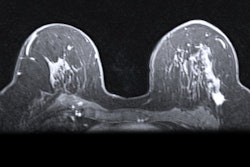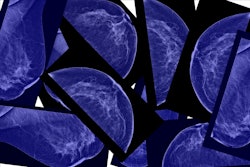Multiparametric MRI helps predict breast cancer treatment response, according to a report on the RSNA's Breast Multiparametric MRI for prediction of neoadjuvant chemotherapy Response (BMMR2) challenge published January 5 in Radiology: Imaging Cancer.
The findings suggest that MRI could offer an effective way to tailor the care of women with the disease, wrote a team led by Wen Li, PhD, of the University of California, San Francisco.
"Outcomes of the BMMR2 challenge provide further compelling evidence of the value of functional breast MRI as an early marker of treatment response that may aid in critical escalation and de-escalation decisions," Li and colleagues noted.
Neoadjuvant therapy is the standard method for treating breast cancer, and quantitative MRI metrics have "shown promise for predicting individual treatment outcome, which could aid in personalizing therapies," the authors wrote. In an effort to explore the efficacy of MRI for this indication, the RSNA held the BMMR2 challenge between May and December of 2021, asking participants to identify image-based markers taken from multiparametric breast MR imaging -- including diffusion-weighted imaging (DWI) and dynamic contrast-enhanced (DCE) MR imaging -- as well as clinical data (i.e., race, sex, HR2/HER2 subtype, lesion type) that could help predict whether a patient would have a complete response following neoadjuvant treatment. Eight teams participated.
The challenge included data from 573 breast MRI exams procured from 191 women for the I-SPY 2/American College of Radiology Imaging Network (ACRIN) 6698 trial; the cohort was split into training (60%) and test (40%) sets, with teams blinded to test set pathologic complete response outcomes. Prediction performance was assessed by area under the receiver operating characteristic curve (AUC) and compared with the benchmark established in the trial's primary analysis.
Three teams reported AUC point estimators higher than the ACRIN 6698's benchmark performance metrics based on particular model approaches:
| Top three best-performing BMMR2 challenge MRI-based algorithms for predicting breast cancer treatment outcome | ||
|---|---|---|
| Team | Model approach | AUC |
| Benchmark | Logistic regression that combined mean apparent diffusion coefficient with tumor HR/HER2 subtype | 0.78 |
| Team A | DCE MRI radiomics-based | 0.8 |
| Team B | Multiparametric MRI radiomics-based | 0.84 |
| Team C | DWI volumetric-based | 0.84 |
"The predictive performance of [the top three teams'] methods … are among the highest values reported in multisite breast imaging trials using DWI or DCE MRI," Li's group reported.
The top performing model was surprising in that it not only outperformed the original A6698 trial model, but it was predictive earlier (using MR data at three weeks into treatment versus 12 weeks for the original model), corresponding author Savannah Partridge, PhD, told AuntMinnie.com.
"Another of the top three models was also surprising because it was predictive at the early-treatment timepoint and utilized only diffusion-weighted MRI data, highlighting the potential role of non-contrast diffusion MRI (not yet a standard breast MRI sequence) for treatment assessment," she noted.
The challenge was successful in identifying a number of models with high predictive performance for assessing breast cancer treatment response, according to the authors.
"The results of the BMMR2 challenge, especially the winning models, demonstrate great potential for multiparametric breast MRI to monitor response in patients undergoing neoadjuvant treatment," they concluded. "Importantly, many of the challenge participants have agreed to make their models available to the research community, which will help bring these methods closer to clinical practice."
The complete study can be found here.



.fFmgij6Hin.png?auto=compress%2Cformat&fit=crop&h=100&q=70&w=100)




.fFmgij6Hin.png?auto=compress%2Cformat&fit=crop&h=167&q=70&w=250)











